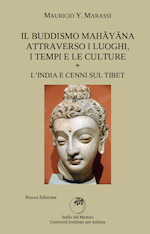But when it was breaking into China, the “stay seated”, the practice, usually called dhyāna, had at least ten centuries of history in the Vedic and pre-Vedic religious culture and six centuries in the Buddhist tradition. Not only had the inner posture of that “stay seated” reached high levels of refinement. Also, by that time, profound – and at times irreconcilable – differences had grown solidified, between the Buddhist and the other Hindu traditions, and within the Buddhist tradition itself concerning how to bring to life this act that may seem always the same.
Therefore, in China, the “stay seated” in the Buddhist tradition for a very long time did not have a clear and coherent development. The words employed to describe that form of sitting kept changing for centuries until translations from ancient Buddhist texts (13) began to put things back in order. But it was only starting from the fourth/fifth century (14) that the “stay seated” we have learnt from the Japanese Zen tradition, was finally grasped and handed down from one generation to another.
Linguistic archaeology, which examines the footprints left by words, witnesses the progressive unfolding and the in-depth elaboration of the Indian tradition that was brought about by the Chinese appropriation of the Lankāvatārasūtra, of the Lotus Sutra, of the Nirvana Sutra, of the Sutra of Vimalakirti, of the Diamond Sutra and of the Heart Sutra. This process led first to approaches somewhat swinging between the emptiness of the Mādhyamika school and the idealistic phenomenology of the Vijñānavāda-Yogācāra and then to the autonomous and original production of important texts, like the Dasheng Qixinlun already quoted, and the Zhengdaoge (15), The song in witness to the path.
So we go from Niutou (“Oxhead”) Farong’s (16) “there is neither spirit nor Buddha” to its antithesis, “be spirit, be Buddha” by the great Mazu Daoyi (17). In the process we walk by Shitou (“Rockhead”) Xiqian (18) who, describing his own inner experience, said : «The boundless sky does not hinder the floating white clouds». Let’s recall also the “shine in silence” championed by Hongzhi Zhengjue (19). To arrive, in the 13th century, to Tiantong Roujing and Dōgen’s “free yourself of body and mind: body and mind freed”. In more recent times, we have heard Uchiyama Kōshō’s “open the hands of thought” (20) and “to sit zazen: end-all” (21) the well known “motto” of his predecessor Sawaki Kōdō. And here we are now.
While following the traces of the words between naishkramya and Uchiyama, we have neglected the two other faces of the triad that have always composed the universal as it can be expressed in human terms: the shape of the body and the moral ethics.
Insofar as the former -the “stay seated”- is concerned, there is a painstaking string of information and face-to-face transmissions along the centuries. Therefore those who, like we, belong to Dōgen’s school can be serenely confident that the way we sit is probably the most refined way possible in this art. Insofar as the ethics is concerned, instead, I am afraid there are problems.
IV) Ethics: is it optional?
Buddhism in isolation does not exist. It has neither a substance that can be grasped nor clear boundaries. Since it is not of “this world”, it would be invisible if it did not cover its nudity. It has to change appearances at every cultural setting it comes into contact. This capacity and necessity to adapt has resulted in the emergence of many local forms of Buddhism. It is so that, perhaps one should not speak of “buddhism”, but of “buddhisms”, in the plural. Of course, these forms may well be different in their external manifestations, but are identical at the same time, and it could not be otherwise, for they all sprout from the very same tree. So, when Buddhism came to a new life in China, it has used the Chinese clay.
At the end of the long and difficult process we mentioned above -hundreds of years where the inner forms of sitting were deeply experienced- the way of “stay seated” born during the Śākyamuni waking under the bodhi-tree has not changed, except insofar as the dress and the body shape of the practitioners.
For what concerns the knowledge around the relation between man and the absolute … you all know that China was not in any way lagging behind India. The ancient and profound Buddhist knowledge could be born there again, if any, even fresher. Only the ethics question remains. The fact is that, West of the Himalayas, the concept of ethics, of right and wrong, of good and bad is profoundly different from the concept of ethics that was influential East of the Himalayas. Therefore, when Buddhism spread through the bones and marrow of the Chinese culture, this difference penetrated deeply into its flesh.
Notes:
13) The most ancient translations into Chinese of texts that mention the “sitting” are, perhaps, those of the Buddhist monk from Sogdiana Kang Seng-hui who, between the third and fourth century, translated the Sūtra of sitting in dhyāna with the title Zuo chan jing 坐 禅 經. Kumarajiva, perhaps in 402, translated the Sūtra of samādhi of sitting in dhyāna with the title Zuo chan sanmei jing 坐 禅 三 昧 經 .
14) The zazen practice, together with the study of the texts of the prajñāpāramitā began, perhaps, in the Huiyuan, 慧 遠 344-416, monastery. Huiyuan stressed the distinction between the Buddhist spiritual ethics from the Confucian ethics based on social relations.
15) 証 道 歌, it is known under the Japanese name of Shōdōka, attributed to Yongjia Xuanjue (in Japanese Yōka Genkaku), 665-713.
16) 594-657, in Japanese Gozu Hōyū, a disciple of the fourth patriarch of the Chan school, Dayi Daoxin (580-651). His statement reminds one of the negation of Nāgārjuna and of the Madhyamaka (or Mādhyamika), “those of the middle”.
17) 709-788, in Japanese Baso Dōitsu, perhaps Chan’s greatest figure.
18) 700-790, in Japanese Sekitō Kisen, author of Can Tong Qi, Understanding the one and the many; in Japanese Sandōkai.
19) 1091-1157, in Japanese Wanshi Shōgaku.
20) In Japanese “atama no tebanashi”, or: 頭の手離 し.
21) In Japanese “zazen shitara oshimai”, or: 坐禅したら 御仕舞い.
Se volete, lasciate un commento.
You must be logged in to post a comment.







